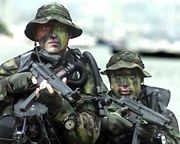Heckler & Koch MP5
| MP5 | |
|---|---|
 |
|
| Type | Submachine gun |
| Place of origin | |
| Service history | |
| In service | 1966–present |
| Used by | See Users |
| Production history | |
| Designer | Tilo Möller, Manfred Guhring, Georg Seidl, Helmut Baureuter |
| Designed | 1964–1966 |
| Manufacturer | Heckler & Koch |
| Produced | 1966–present |
| Variants | See Variants |
| Specifications | |
| Weight | 2.54 kg (5.6 lb) (MP5A2, MP5A4) 3.08 kg (6.8 lb) (MP5A3, MP5A5) 2 kg (4.4 lb) (MP5K, MP5KA1, MP5KA4, MP5KA5) 2.78 kg (6.1 lb) (MP5K-PDW) 2.80 kg (6.2 lb) (MP5SD1, MP5SD4) 3.10 kg (6.8 lb) (MP5SD2, MP5SD5) 3.60 kg (7.9 lb) (MP5SD3, MP5SD6) 2.67 kg (5.9 lb) fixed stock / 2.85 kg (6.3 lb) retractable stock (MP5/10) 2.67 kg (5.9 lb) fixed stock / 2.85 kg (6.3 lb) retractable stock (MP5/40) |
| Length | Fixed stock: 680 mm (26.8 in) (MP5A2, MP5A4, MP5/10, MP5/40) 790 mm (31.1 in) (MP5SD2, MP5SD5) Telescoping stock: 700 mm (27.6 in) stock extended / 550 mm (21.7 in) stock collapsed (MP5A3, MP5A5) 603 mm (23.7 in) stock extended / 368 mm (14.5 in) stock folded (MP5K-PDW) 805 mm (31.7 in) stock extended / 670 mm (26.4 in) stock collapsed (MP5SD3, MP5SD6) 660 mm (26.0 in) stock extended / 490 mm (19.3 in) stock collapsed (MP5/10, MP5/40) Receiver end cap: 325 mm (12.8 in) (MP5K, MP5KA1, MP5KA4, MP5KA5) 349 mm (13.7 in) (MP5K-PDW) 550 mm (21.7 in) (MP5SD1, MP5SD4) |
| Barrel length | 225 mm (8.9 in) (MP5A2, MP5A3, MP5A4, MP5A5, MP5/10, MP5/40) 115 mm (4.5 in) (MP5K, MP5KA1, MP5KA4, MP5KA5) 140 mm (5.5 in) (MP5K-PDW) 146 mm (5.7 in) (MP5SD1, MP5SD2, MP5SD3, MP5SD4, MP5SD5, MP5SD6) |
| Width | 50 mm (2.0 in) (MP5A2, MP5A3, MP5A4, MP5A5, MP5K, MP5KA1, MP5KA4, MP5KA5, MP5K-PDW, MP5/10, MP5/40) 60 mm (2.4 in) (MP5SD1, MP5SD2, MP5SD3, MP5SD4, MP5SD5, MP5SD6) |
| Height | 260 mm (10.2 in) (MP5A2, MP5A3, MP5A4, MP5A5, MP5SD1, MP5SD2, MP5SD3, MP5SD4, MP5SD5, MP5SD6, MP5/10, MP5/40) 210 mm (8.3 in) (MP5K, MP5KA1, MP5KA4, MP5KA5, MP5K-PDW) |
|
|
|
| Cartridge | 9x19mm Parabellum 10mm Auto (MP5/10) .40 S&W (MP5/40) |
| Action | Roller-delayed blowback, closed bolt |
| Rate of fire | 700 rounds/min (MP5SD series), 800 rounds/min (MP5A series, MP5/10 and MP5/40), 900 rounds/min (MP5K series) |
| Muzzle velocity | 400 m/s (1,312 ft/s) (MP5A2, MP5A3, MP5A4, MP5A5) 375 m/s (1,230.3 ft/s) (MP5K, MP5KA1, MP5KA4, MP5KA5, MP5K-PDW) 285 m/s (935.0 ft/s) (MP5SD1, MP5SD2, MP5SD3, MP5SD4, MP5SD5, MP5SD6) 425 m/s (1,394.4 ft/s) (MP5/10) 315 m/s (1,033.5 ft/s) (MP5/40) |
| Feed system | 15- or 30- or 32- round detachable box magazine, 100-round Beta C-Mag drum magazine |
| Sights | Iron sights. Rear: rotary drum; front: hooded post |
The Heckler & Koch MP5 (From Maschinenpistole 5 - German: "machine pistol model 5") is a 9mm submachine gun of German design, developed in the 1960s by a team of engineers from the German small arms manufacturer Heckler & Koch GmbH (H&K) of Oberndorf am Neckar.
The MP5 is currently one of the most widely used submachine guns in the world,[1] having been adopted by numerous law enforcement agencies and special forces groups. In the 1990s, Heckler & Koch developed the Heckler & Koch UMP, the MP5's successor, though both remain in production.[2]
Contents |
History
Heckler & Koch, encouraged by the success of the G3 automatic rifle, developed a family of small arms consisting of four types of firearms (all based on a common G3 design layout and operating principle), where the first type was chambered in 7.62x51mm NATO, the second—using the 7.62x39mm M43 round, third—the intermediate 5.56x45mm NATO caliber and the fourth type—chambering the 9x19mm Parabellum pistol cartridge. The MP5 was created within the fourth group of firearms and was initially known as the HK54.
Work on the MP5 began in 1964 and scarcely two years later it was adopted by the German Federal Police, border guard and army special forces.
The MP5 is manufactured under license in several nations including Greece (formerly at EBO - Hellenic Arms Industry, currently at EAS - Hellenic Defense Systems), Iran (Defense Industries Organization), Mexico (SEDENA), Pakistan (Pakistan Ordnance Factories), Saudi Arabia, Sudan (Military Industry Corporation), Turkey (MKEK), and the United Kingdom (initially at Royal Ordnance, later diverted to Heckler & Koch Great Britain).[3]
Design details
The primary version of the MP5 family is the MP5A2, which is a lightweight, air-cooled, selective fire delayed blowback operated 9x19mm Parabellum weapon with a roller-delayed bolt. It fires from a closed bolt (bolt forward) position.
The fixed, free floating, cold hammer-forged barrel has 6 right-hand grooves with a 1 in 250 mm (1:10 in) rifling twist rate and is pressed and pinned into the receiver.
Features
The first MP5 models used a double-column straight box magazine, but since 1977, slightly curved, steel magazines are used with a 15-round capacity (weighing 0.12 kg) or a 30-round capacity (0.17 kg empty).

The sighting arrangement on the MP5 takes advantage of the natural ability of the eye and brain to easily align concentric circles (circles all having a common center). The mechanically adjustable iron sights (closed type) consist of a rotating rear diopter drum and a front post installed in a hooded ring. The rear sight is adjustable for both windage and elevation with the use of a special tool; the drum provides four different apertures of varying width used for firing at 25, 50, 75 and 100 m. However, adjusting the rear drum does not change the elevation or bullet strike of the rounds since the MP5 uses pistol cartridges, which share a similar point of impact between 25 and 100 m when zeroed at 25 m.
The MP5 has a hammer firing mechanism. The trigger group is housed inside an interchangeable polymer trigger module (with an integrated pistol grip) and equipped with a 3-position fire mode selector that serves as the manual safety toggle. The “S” or Sicher position in white denotes weapon safe, “E” or Einzelfeuer in red represents single fire, and “F” or Feuerstoß (also marked in red) designates continuous fire. The SEF symbols appear on both sides of the plastic trigger group. The selector lever is actuated with the thumb of the shooting hand and is located only on the left side of the original SEF trigger group or on both sides of the ambidextrous trigger groups. The safety/selector is rotated into the various firing settings or safety position by depressing the tail end of the lever. Tactile clicks (stops) are present at each position to provide a positive stop and prevent inadvertent rotation. The "safe" setting disables the trigger by blocking the hammer release with a solid section of the safety axle located inside the trigger housing.
The non-reciprocating cocking handle is located above the handguard and protrudes from the cocking handle tube at approx. a 45° angle. This rigid control is attached to a tubular piece within the cocking lever housing called the cocking lever support, which in turn, makes contact with the forward extension of the bolt group. It is not however connected to the bolt carrier and therefore cannot be used as a forward assist to fully seat the bolt group. The cocking handle is held in a forward position by a spring detent located in the front end of the cocking lever support which engages in the cocking lever housing. The lever is locked back by pulling it fully to the rear and rotating it slightly clockwise where it can be hooked into an indent in the cocking lever tube.
Operating mechanism
The bolt rigidly engages the barrel extension – a cylindrical component welded to the receiver that the barrel is pinned into. The delay mechanism is of the same design as that used in the G3 rifle. The two-part bolt consists of a bolt head with rollers and a bolt carrier. The heavier bolt carrier lies up against the bolt head when the weapon is ready to fire and inclined planes on the front locking piece lie between the rollers and force them out into recesses in the barrel extension.[4]

When fired, expanding propellant gases produced from the burning powder in the cartridge exert rearward pressure on the bolt head transferred through the base of the cartridge case as it is propelled out of the chamber. A portion of these forces is transmitted through the rollers projecting from the bolt head, which are cammed inward against the inclined flanks of the locking recesses in the barrel extension and to the angled shoulders of the locking piece. The selected angles of the recesses and the incline on the locking piece produce a velocity ratio of about 4:1 between the bolt carrier and the bolt head. This results in a calculated delay, allowing the projectile to exit the barrel and gas pressure to drop to a safe level before the case is extracted from the chamber.

The delay results from the amount of time it takes for enough recoil energy to be transferred through to the bolt carrier in a sufficient quantity for it to be driven to the rear against the force of inertia of the bolt carrier and the forward pressure exerted against the bolt by the recoil spring. As the rollers are forced inward they displace the locking piece and propel the bolt carrier to the rear. The bolt carrier's rearward velocity is four times that of the bolt head since the cartridge remains in the chamber for a short period of time during the initial recoil impulse. After the bolt carrier has traveled rearward 4 mm, the locking piece is withdrawn fully from the bolt head and the rollers are compressed into the bolt head. Only once the locking rollers are fully cammed into the bolt head can the entire bolt group continue its rearward movement in the receiver, breaking the seal in the chamber and continuing the feeding cycle.
Since the 9x19mm Parabellum cartridge is relatively low powered, the bolt does not have an anti-bounce device like the G3, but instead the bolt carrier contains tungsten granules that prevent the bolt group from bouncing back after impacting the barrel extension. The weapon has a fluted chamber that enhances extraction reliability by bleeding gases backwards into the shallow flutes running along the length of the chamber to prevent the cartridge case from expanding and sticking to the chamber walls (since the bolt is opened under relatively high barrel pressure). A spring extractor is installed inside the bolt head and holds the case securely until it strikes the ejector arm and is thrown out of the ejection port to the right of the receiver. The lever-type ejector is located inside the trigger housing (activated by the movement of the recoiling bolt).
Accessories
Three lugs are provided at the muzzle that are used to work with certain muzzle devices made by Heckler & Koch, including: a slotted flash suppressor, blank firing attachment (marked with a red painted band denoting use with blank ammunition only), an adaptor for launching rifle grenades (for use with rifle-style grenades with an inside diameter of 22 mm using a special grenade launching cartridge) and a cup-type attachment used to launch tear gas grenades.
The receiver housing has notches that permit the attachment of a standard Heckler & Koch quick-detachable scope mount (also used with the G3, HK33 and G3SG/1) that can be used to mount daytime optical sights (telescopic 4x24), night sights or a halogen flashlight. It can be used with reflex sights and laser pointers. The mount features two spring-actuated bolts, positioned along the base of the mount, which exert pressure on the receiver to hold the mount in the same position at all times assuring zero retention. All versions of the quick-detachable scope mount provide a sighting tunnel through the mount so that the shooter can continue to use the fixed iron sights with the scope mount attached to the top of the receiver.
Variants

The MP5A2 has a fixed stock (made of a synthetic polymer), whereas the compact MP5A3 has a retractable metal stock.
In the early 1970s HK introduced a conversion kit for the MP5 that enables it to use sporting ammunition (.22 LR). This unit consists of a barrel insert, a bolt group and two 20-round magazines. This modification reduces the cyclic rate to 650 rounds/min.
The MP5A2 and MP5A3 are available with optional 4-position trigger groups; these are known as the MP5A4 and MP5A5 respectively. The trigger groups are marked with bullet pictograms rather than letters or numbers (each symbol represents the number of bullets that will be fired when the trigger is pulled and held rearward with a full magazine inserted in the weapon) and are fully ambidextrous (the selector lever is present on each side of the trigger housing). The additional setting of the fire selector, one place before the fully automatic setting, enables a two or three-shot burst firing mode. H&K offers dedicated training variants of these weapons, designated MP5A4PT and MP5A5PT (PT - Plastic Training), modified to fire a plastic 9x19mm PT training cartridge produced by Dynamit Nobel of Germany. These weapons operate like the standard MP5 but have a floating chamber and the bolt lacks both rollers to function properly when firing the lighter plastic projectiles. To help identify these weapons blue dots were painted on their cocking handles and additional lettering provided. The PT variant can be configured with various buttstocks and trigger groups and was developed for the West German Police and Border Guard.

The modular design of the MP5 offers multiple trigger groups: three-position "SEF" fire selector (positions: "S"-safe, "E"-semi automatic, "F" fully automatic. Located on left of receiver only); three-position fire selector (positions: safe, semiautomatic and a 2 or 3-round burst; selector lever is ambidextrous and its settings are marked with pictograms); four-position fire selector (positions: weapon safe, single fire, 2 or 3-round burst, full auto; ambidextrous selector; selector settings marked with pictograms); two-position fire control group (positions: weapon safe, single fire only; ambidextrous selector lever with pictograms) and a three-position fire selector group - the so called “Navy” trigger (settings: weapon safe, semi-automatic, fully automatic fire; ambidextrous selector lever; selector settings marked with bullet symbols again).
A variant with the last trigger group designated the MP5-N (N – Navy) was developed in 1986 for the United States Navy. This model has a collapsible stock, a tritium-illuminated front sight post and a 225 mm (8.9 in) threaded barrel for use with a stainless steel sound suppressor made by Knight's Armament Company together with suppressed subsonic ammunition.
Civilian variants
The MP5SFA2 (SF - single-fire) is the same as the MP5A2 but is fitted with an ambidextrous semi-automatic only trigger group. Versions delivered after December 1991 are assembled with select-fire bolt carriers allowing fully automatic operation when used with the appropriate trigger module. Developed in 1986 in response to the American FBI solicitation for "9 mm Single-fire Carbines". The MP5SFA3 features a retractable metal stock.
The two-position trigger unit was used in the single-fire HK94 carbine that was produced specifically for the civilian market with a 420 mm (16.5 in) barrel.
Suppressed variants
In 1974 H&K initiated design work on a sound-suppressed variant of the MP5, designated the MP5SD (SD – Schalldämpfer German for "sound dampener"), which features an integral but detachable aluminium sound suppressor and a lightweight bolt. The weapon's 146 mm (5.7 in) barrel has 30 2.5 mm (0.1 in) ports drilled forward of the chamber through which escaping gases are diverted to the surrounding sealed tubular casing that is screwed on to threading on the barrel’s external surface just prior to the ported segment. The suppressor itself is divided into two stages; the initial segment surrounding the ported barrel serves as an expansion chamber for the propellant gases, reducing gas pressure to slow down the acceleration of the projectile. The second, decompression stage occupies the remaining length of the suppressor tube and contains a stamped metal helix separator with several compartments which increase the gas volume and decrease its temperature, deflecting the gases as they exit the muzzle, so muffling the exit report. The bullet leaves the muzzle at subsonic velocity, so it does not generate a sonic shock wave in flight. As a result of reducing the barrel’s length and venting propellant gases into the suppressor, the bullet’s muzzle velocity was lowered anywhere from 16% to 26% (depending on the ammunition used) while maintaining the weapon’s automation and reliability. The weapon was designed to be used with standard supersonic ammunition with the suppressor on at all times.
The MP5SD is produced exclusively by H&K in several versions: the MP5SD1 and MP5SD4 (both have a receiver end cap instead of a buttstock), MP5SD2 and MP5SD5 (equipped with a fixed synthetic buttstock) and the MP5SD3 and MP5SD6 (fitted with a collapsible metal stock). The MP5SD1, MP5SD2 and MP5SD3 use a standard "SEF" trigger group (from the MP5A2 and MP5A3), while the MP5SD4, MP5SD5 and MP5SD6 – a trigger module with a mechanically limited 3-round burst mode and ambidextrous selector controls (from the MP5A4 and MP5A5). A suppressed version was produced for the U.S. Navy - designated the MP5SD-N, which is a version of the MP5SD3 with a retractable metal stock, front sight post with tritium-illuminated dot and a stainless steel suppressor. This model has a modified cocking handle support to account for the slightly larger outside diameter of the suppressor. The design of the suppressor allows the weapon to be fired with water inside, should water enter the device during operation in or near water.
MP5K

In 1976 a shortened version of the MP5A2 was introduced; the MP5K (K from the German word Kurz = "short") was designed for close quarters battle use by clandestine operations and special services. The MP5K does not have a shoulder stock (the receiver end was covered with a flat cover), and the bolt and receiver were shortened at the rear. The resultant lighter bolt led to a higher rate of fire than the standard MP5. The barrel, cocking handle and its cover were shortened and a vertical foregrip was used to replace the standard handguard. The barrel ends at the base of the foresight, which prevents the use of any sort of muzzle device.
The MP5K is produced (by Heckler & Koch and under license in Iran and Turkey) in four different versions: the MP5K, MP5KA4, MP5KA1, MP5KA5, where the first two variants have adjustable, open-type iron sights (with a notched rotary drum), and the two remaining variants - fixed open sights, however the front sight post was changed and a notch was cut into the receiver top cover. The MP5K retained the capability to use optical sights through the use of an adapter.
A civilian semiautomatic derivative of the MP5K known as the SP89 was produced that had a foregrip with a muzzle guard in place of the vertical grip.
In 1991 a further variant of the MP5K was developed, designated the MP5K-PDW (PDW – Personal Defense Weapon) that retained the compact dimensions of the MP5K but restored the fire handling characteristics of the full-size MP5A2. The MP5K-PDW uses a side-folding synthetic shoulder stock (made by the U.S. company Choate Machine and Tool), a “Navy” trigger group, a front sight post with a built-in tritium insert and a slightly lengthened threaded, three-lug barrel (analogous to the MP5-N). The stock can be removed and replaced with a receiver endplate; a rotary drum with apertures from the MP5A2 can also be used.
Larger caliber versions
In 1991, Heckler & Koch introduced the MP5/10 (chambered in 10mm Auto) and MP5/40 (chambered for the .40 S&W cartridge), which are based on the MP5A4 and MP5A5. These weapons were assembled in fixed and retractable stock configurations (without a separate designation) and are fed from translucent 30-round polymer box magazines.[5] These weapons include a bolt hold-open device, which captures the bolt group in its rear position after expending the last cartridge from the magazine. The bolt is then released by pressing a lever positioned on the left side of the receiver. Both weapons use a barrel with 6 right-hand grooves and a 380 mm (1:15 in) twist rate, and like the MP5-N, both have a 3-lugged muzzle device and a tritium-illuminated front sight aiming dot.
Variants list



- HK54: The original model that was produced in the mid 1960s. It later became known as the MP5A1, a very slightly modified version. No buttstock (endplate/receiver cap in place of buttstock), "Navy"/"SEF" trigger group.
- MP5A2: Fixed buttstock, "SEF" trigger group.
- MP5SFA2: Fixed buttstock, single-fire (SF) trigger group.
- MP5A3: Retractable buttstock,"SEF" trigger group.
- MP5SFA3: Retractable buttstock, single-fire (SF) trigger group.
- MP5A4: Fixed buttstock, 3-round burst trigger group.
- MP5A5: Retractable buttstock, 3-round burst trigger group.
- MP5-N: Model developed specifically for the U.S. Navy. Ambidextrous "Navy" trigger group, 3-lug/threaded barrel for attaching a sound suppressor; retractable stock.
- MP5F: Model developed specifically for the French military. Rubber-padded retractable stock, ambidextrous sling loops/bolts and internal modifications to handle high-pressure ammunition.
- MP5K: Short (Kurz) version, "SEF" trigger group.
- MP5KA1: MP5K with smooth upper surface and small iron sights; "SEF" trigger group.
- MP5KA4: MP5K with 3-round burst trigger group.
- MP5KA5: MP5KA1 with 3-round burst trigger group.
- MP5K-N: MP5K with "Navy" trigger group and 3-lug/threaded barrel for mounting suppressors or other muzzle attachments.
- MP5K-PDW: Personal Defense Weapon; MP5K-N with added folding stock and 3-lug/threaded barrel for mounting of suppressors; "Navy" or 3-round burst trigger group. Introduced in 1991.
- MP5SD1: No buttstock (endplate/receiver cap in place of buttstock), "SEF" trigger group, integrated suppressor (Schalldämpfer)
- MP5SD2: Fixed buttstock, "SEF" trigger group, integrated suppressor.
- MP5SD3: Retractable buttstock, "SEF" trigger group, integrated suppressor.
- MP5SD4: No buttstock (endplate/receiver cap in place of buttstock), 3-round burst trigger group, integrated suppressor.
- MP5SD5: Fixed buttstock, 3-round burst trigger group, integrated suppressor.
- MP5SD6: Retractable buttstock, 3-round burst trigger group, integrated suppressor.
- MP5SD-N1: Retractable buttstock, "Navy" trigger group, KAC stainless steel suppressor.
- MP5SD-N2: Fixed buttstock, "Navy" trigger group, KAC stainless steel suppressor.
- MP5/10: Chambered in 10mm Auto, available in various stock/trigger group configurations. It was produced from 1992 to 2000.
- MP5/40: Chambered in .40 S&W, available in various stock/trigger group configurations. It was produced from 1992 to 2000.
- HK94: American import model of the MP5 with a 16 in barrel and special safe/semi-automatic trigger group, designed for civilian use. It was made from 1983 to 1989, in three different configurations. Some of these were converted to fire in fully automatic by movie armorers and used to stand in for the MP5 in various movies during the 1980s and 1990s, due to most of the real MP5s being imported into the United States at the time being earmarked for military and law enforcement sales. These 'fake' MP5s can often be identified by the lack of the paddle-style magazine release between the magazine well and trigger guard as well as having smooth barrels with no lugs or threading.
- SP89: Sport Pistole M1989. Semi-automatic only version of the MP5K designed for civilian use. It had a modified foregrip redesigned into a traditional handguard to make it compliant with the Semi-Auto Weapons Ban of 1989. It was made from 1989 to 1994. As with the HK94 mentioned above, some of these weapons were also used to stand in for their select-fire counterparts in films and television.
Users
 Australia: Royal Australian Air Force Airfield Defence Guards, Special Operations Command, and all Police Tactical Groups.[6]
Australia: Royal Australian Air Force Airfield Defence Guards, Special Operations Command, and all Police Tactical Groups.[6] Austria: EKO Cobra.[7]
Austria: EKO Cobra.[7] Bangladesh: Army, Special Forces, Rapid Action Battalion, and Bangladesh Navy Special Warfare Diving And Salvage.[8]
Bangladesh: Army, Special Forces, Rapid Action Battalion, and Bangladesh Navy Special Warfare Diving And Salvage.[8] Canada: Canadian Forces Naval Boarding Party,[9] Royal Canadian Mounted Police.[10]
Canada: Canadian Forces Naval Boarding Party,[9] Royal Canadian Mounted Police.[10] Croatia: Lučko Anti-Terrorist Unit [11]
Croatia: Lučko Anti-Terrorist Unit [11] Czech Republic: URNA counter-terrorist group[12] and other units of the armed forces (MP5A5, MP5SD6, MP5K-PDW).[13]
Czech Republic: URNA counter-terrorist group[12] and other units of the armed forces (MP5A5, MP5SD6, MP5K-PDW).[13] Estonia:Estonian Police.[14]
Estonia:Estonian Police.[14] Finland: Finnish Defence Forces under designation 9.00 konepistooli 2000.[15]
Finland: Finnish Defence Forces under designation 9.00 konepistooli 2000.[15] France: GIGN[12] and certain specialized units within the French Army.[16][17]
France: GIGN[12] and certain specialized units within the French Army.[16][17] Germany: Bundespolizei, Landespolizei,[18] German Army, Feldjäger,[19] GSG 9 special operations unit[20] and German Navy.[21]
Germany: Bundespolizei, Landespolizei,[18] German Army, Feldjäger,[19] GSG 9 special operations unit[20] and German Navy.[21] Greece: Manufactured locally by Hellenic Defence Systems (EAS: Ellinika Amyntika Systimata).[22] Used by the EKAM counter-terrorist group.[23]
Greece: Manufactured locally by Hellenic Defence Systems (EAS: Ellinika Amyntika Systimata).[22] Used by the EKAM counter-terrorist group.[23] India: Indian Army, MARCOS, National Security Guards, and Maharashtra State Force One.[24] Also used by the Special Protection Group until 2008, when it was replaced with the FN P90 and FN F2000.[25]
India: Indian Army, MARCOS, National Security Guards, and Maharashtra State Force One.[24] Also used by the Special Protection Group until 2008, when it was replaced with the FN P90 and FN F2000.[25] Indonesia: Komando Pasukan Katak (Kopaska) tactical diver group and Komando Pasukan Khusus (Kopassus) special forces group.[26]
Indonesia: Komando Pasukan Katak (Kopaska) tactical diver group and Komando Pasukan Khusus (Kopassus) special forces group.[26] Iran: Produced under license.[3]
Iran: Produced under license.[3] Ireland: Irish Army Rangers.[27]
Ireland: Irish Army Rangers.[27] Jamaica: Jamaica Constabulary Force.[28]
Jamaica: Jamaica Constabulary Force.[28] Japan: Special Boarding Unit.[29]
Japan: Special Boarding Unit.[29] Kenya: Kenya Police.[30][31]
Kenya: Kenya Police.[30][31] Lithuania: Lithuanian Armed Forces.[32]
Lithuania: Lithuanian Armed Forces.[32] Luxembourg: Unité Spéciale de la Police intervention unit of the Grand Ducal Police.[33]
Luxembourg: Unité Spéciale de la Police intervention unit of the Grand Ducal Police.[33] Malaysia: Malaysian Armed Forces, Royal Malaysian Police, Malaysian Coast Guard and other special forces units and national security agencies.[34]
Malaysia: Malaysian Armed Forces, Royal Malaysian Police, Malaysian Coast Guard and other special forces units and national security agencies.[34] Mexico: Manufactured under license.[35]
Mexico: Manufactured under license.[35] Netherlands: Dutch Royal and Diplomatic security (DKDB).[36]
Netherlands: Dutch Royal and Diplomatic security (DKDB).[36] New Zealand: New Zealand Special Air Service and New Zealand Police Special Tactics Group [37]
New Zealand: New Zealand Special Air Service and New Zealand Police Special Tactics Group [37] Norway: Norwegian Defence Force, to be replaced by the MP7.[38] Norwegian Police Service[39]
Norway: Norwegian Defence Force, to be replaced by the MP7.[38] Norwegian Police Service[39] Pakistan: Pakistan Army, built by Pakistan Ordnance Factories.[40]
Pakistan: Pakistan Army, built by Pakistan Ordnance Factories.[40] Philippines: Armed Forces of the Philippines, and Philippine National Police Special Action Force and other police and SWAT units.[41]
Philippines: Armed Forces of the Philippines, and Philippine National Police Special Action Force and other police and SWAT units.[41] Poland: GROM special forces unit.[42]
Poland: GROM special forces unit.[42] Portugal: Grupo de Operações Especiais (GOE).[43]
Portugal: Grupo de Operações Especiais (GOE).[43] Romania: Land Forces Special Operations battalions.[44]
Romania: Land Forces Special Operations battalions.[44] Saudi Arabia: Produced under license.[3]
Saudi Arabia: Produced under license.[3] Serbia[45]
Serbia[45] Singapore: Singapore Armed Forces Commando Formation.[46]
Singapore: Singapore Armed Forces Commando Formation.[46] Slovakia: Slovak Armed Forces and Slovak Police special forces and counter-terrorist forces.[47]
Slovakia: Slovak Armed Forces and Slovak Police special forces and counter-terrorist forces.[47] Spain: Grupo Especial de Operaciones (GEO).[48]
Spain: Grupo Especial de Operaciones (GEO).[48] Sudan: Manufactured by Military Industry Corporation as the Tihraga.[49]
Sudan: Manufactured by Military Industry Corporation as the Tihraga.[49] Sweden: Swedish Police Service.[50]
Sweden: Swedish Police Service.[50] Taiwan[45]
Taiwan[45] Turkey: Various services, manufactured by MKEK.[51]
Turkey: Various services, manufactured by MKEK.[51] United Kingdom: Produced under license.[3] Used by the Special Air Service,[20] CO19,[52] and most Authorised Firearms Officers.[53]
United Kingdom: Produced under license.[3] Used by the Special Air Service,[20] CO19,[52] and most Authorised Firearms Officers.[53] United States: Special Operations Forces[54] and FBI Hostage Rescue Team.[55] Also used by various police SWAT units at federal, state, and local levels.[56]
United States: Special Operations Forces[54] and FBI Hostage Rescue Team.[55] Also used by various police SWAT units at federal, state, and local levels.[56]
References
- Modern Warfare, Published by Mark Dartford, Marshall Cavendish (London) 1985
- ↑ Hogg, Ian (2002). Jane's Guns Recognition Guide. Jane's Information Group. ISBN 0-00-712760-X.
- ↑ "Heckler & Koch - Group Website". Heckler-koch.com. http://www.heckler-koch.com/HKWebText/detailProd/1926/82/4/20. Retrieved 2009-06-26.
- ↑ 3.0 3.1 3.2 3.3 "Report: Profiling the Small Arms Industry - World Policy Institute - Research Project". World Policy Institute. November 2000. http://www.worldpolicy.org/projects/arms/reports/smallarms.htm. Retrieved 2010-07-15.
- ↑ * Modern Warfare, Published by Mark Dartford, Marshall Cavendish (London) 1985
- ↑ [1]
- ↑ Gillett, Ross (1987). Australia's Armed Forces of the Eighties. Sydney, Australia: Cupress Ltd. pp. 105–106. ISBN 978-0867770810.
- ↑ http://www.bmi.gv.at/cms/BMI_EKO_Cobra/publikationen/files/LawOrder.pdf
- ↑ "MP5 Submachine Gun | Bangladesh Military Forces | BDMilitary.com - The voice of the Bangladesh Armed Forces". BDMilitary.com. http://www.bdmilitary.com/index.php?option=com_content&view=article&id=201&Itemid=95. Retrieved 2010-06-24.
- ↑ http://www.navy.forces.gc.ca/cms/11/11_eng.asp?page=8&keyword=[02-00-DNPA-E
- ↑ "TR-01-95.pdf" (PDF). http://www.css.drdc-rddc.gc.ca/cprc/tr/tr-1995-01.pdf. Retrieved 2010-06-24.
- ↑ [2]
- ↑ 12.0 12.1 Meyr, Eitan (January 06, 1999). "Special Weapons for Counter-terrorist Units". Jane's — Law Enforcement. http://www.janes.com/security/law_enforcement/news/ipi/ipi0312.shtml. Retrieved 2009-09-26.
- ↑ "zbrane.indd" (PDF). http://www.army.cz/assets/files/9334/zbrane_definit.pdf. Retrieved 2010-06-24.
- ↑ DELFI. "Politsei- ja piirivalveamet ostis kuus uut püstolkuulipildujat - DELFI". Delfi.ee. http://www.delfi.ee/news/paevauudised/eesti/politsei--ja-piirivalveamet-ostis-kuus-uut-pustolkuulipildujat.d?id=29276439. Retrieved 2010-06-24.
- ↑ "Puolustusvoimat: Kalustoesittely" (in Finnish). Mil.fi. 2009-05-20. http://www.mil.fi/maavoimat/kalustoesittely/index.dsp?level=63&equipment=45. Retrieved 2009-06-26.
- ↑ "Terre - HK MP5 A5" (in (French)). Defense.gouv.fr. http://www.defense.gouv.fr/terre/decouverte/materiels/materiels_specifiques/hk_mp5_a5. Retrieved 2009-06-26.
- ↑ "Terre - HK MP5 SD3" (in (French)). Defense.gouv.fr. http://www.defense.gouv.fr/terre/decouverte/materiels/materiels_specifiques/hk_mp5_sd3. Retrieved 2009-06-26.
- ↑ "Modern Firearms - Heckler Koch HK MP-5 submacine gun". World.guns.ru. http://world.guns.ru/smg/smg14-e.htm. Retrieved 2010-06-24.
- ↑ "Maschinenpistole MP5K". streitkraeftebasis.de. http://www.streitkraeftebasis.de/portal/a/streitkraeftebasis/kcxml/04_Sj9SPykssy0xPLMnMz0vM0Y_QjzKLNwyON3Y0cgRJQjmGBvqRCPGglFR9X4_83FR9b_0A_YLciHJHR0VFALnNkmM!/delta/base64xml/L2dJQSEvUUt3QS80SVVFLzZfMVNfM0FBMQ!!?yw_contentURL=%2F01DB040000000001%2FW26A9EFM302INFODE%2Fcontent.jsp. Retrieved 2010-06-24.
- ↑ 20.0 20.1 , Miller, David (2001). The Illustrated Directory of 20th Century Guns. Salamander Books Ltd. ISBN 1-84065-245-4.
- ↑ [3]
- ↑ "Hellenic Defense Systems". Eas.gr. http://www.eas.gr/index.php?lang=en&sec=7&cid=113. Retrieved 2009-06-26.
- ↑ "Greece Ministry of Public Order Press Office: Special Anti-Terrorist Unit". http://astynomia.gr - Official Website of the Hellenic Police. July 2004. http://www.astynomia.gr/images/stories/DOCS/Attachment11480_ENHMEROTIKO_EKAM_ENGL.pdf. Retrieved 2009-10-13.
- ↑ "Force One to get MP5 guns". dnaindia.com. 2009-01-16. http://www.dnaindia.com/mumbai/report_force-one-to-get-mp5-guns_1221940. Retrieved 2010-06-24.
- ↑ Unnithan, Sandeep (August 22, 2008). "If Looks Could Kill". India Today (Online). http://indiatoday.intoday.in/site/Story/13607/INDIASCOPE/If+looks+could+kill.html. Retrieved 2009-04-04.
- ↑ "Kopassus & Kopaska - Specijalne Postrojbe Republike Indonezije" (in Croatian). Hrvatski Vojnik Magazine. http://www.hrvatski-vojnik.hr/hrvatski-vojnik/1612007/ind.asp. Retrieved 2010-06-12.
- ↑ "ARW Equipment". Fianoglach.ie. http://www.fianoglach.ie/unitequipment.html. Retrieved 2010-06-24.
- ↑ "Home | RJR News". Radiojamaica.com. 2010-06-11. http://www.radiojamaica.com/content/view/16653/26/. Retrieved 2010-06-24.
- ↑ "日本国の精鋭部隊&特殊部隊" (in Japanese). Archived from the original on 2006-06-28. http://web.archive.org/web/20060628015445/http://www5f.biglobe.ne.jp/~sbu/DATABASE-JAPAN.htm. Retrieved 2009-10-06.
- ↑ http://www.capitalfm.co.ke/news/Kenyanews/Sh25m-Kenya-heist-puzzle-5889.html
- ↑ http://www.africanexecutive.com/modules/magazine/articles.php?article=2868
- ↑ http://kariuomene.kam.lt/lt/ginkluote_ir_karine_technika/pistoletai-kulkosvaidziai/pistoletas_-_kulkosvaidis_mp-5.html
- ↑ "Equipement :: Unité Spéciale de la Police ::". USP.LU. http://www.usp.lu/armement-assault-fr.php. Retrieved 2010-06-24.
- ↑ Thompson, Leroy (December 2008). "Malaysian Special Forces". Special Weapons. http://www.tactical-life.com/online/special-weapons/malaysian-special-forces. Retrieved 2009-11-29.
- ↑ "http://zugzwanged.org/dat/weapons/docs/man/hk_mp5.pdf". http://zugzwanged.org/dat/weapons/docs/man/hk_mp5.pdf.
- ↑ "http://www.arrestatieteam.nl/eenhedenbinnenland/dkdb.php". http://www.arrestatieteam.nl/eenhedenbinnenland/dkdb.php.
- ↑ Media Works NZ / TV3 Documentary - Inside New Zealand - NZSAS: First Among Equals. TVNZ Documentary - Line of Fire. www.army.mil.nz/our-army/nzsas
- ↑ En liten røver med trøkk i (Norwegian article on the Heckler & Koch deal)
- ↑ http://www.vg.no/nyheter/innenriks/artikkel.php?artid=543718
- ↑ "POFs - ProductsOrdnance - Infantry Weapons - SubMachine Gun MP5". Pof.gov.pk. http://www.pof.gov.pk/products/smgs.htm. Retrieved 2009-06-26.
- ↑ "Rice Not Guns - German Arms in the Philippines". Bits.de. http://www.bits.de/public/articles/kw_nl/kleinwaffen-nl04-08eng.htm. Retrieved 2010-06-24.
- ↑ Sebastian Miernik. "//- Strona poświęcona Wojskowej Formacji Specjalnej GROM -//". Grom.mil.pl. http://www.grom.mil.pl/uzbrojenie_pliki/UZBROJENIE.HTM. Retrieved 2010-06-24.
- ↑ Mateus, Bruno Contreiras (July 6, 2008). "Superpolícias Preparados para o Pior" (in Portuguese). Correio da Manhã. http://www.cmjornal.xl.pt/noticia.aspx?channelid=00000019-0000-0000-0000-000000000019&contentid=E88AF539-CD52-4AE6-960D-C60EC1E4083D. Retrieved 2009-10-23.
- ↑ de Mihai DIAC (2008-03-05). "Armament ultrasofisticat pentru Forţele Speciale ale Armatei Române - Gandul". Gandul.info. http://www.gandul.info/armata/armament-ultrasofisticat-pentru-fortele-speciale-ale-armatei-romane-2434924. Retrieved 2010-06-24.
- ↑ 45.0 45.1 Jones, Richard D. Jane's Infantry Weapons 2009/2010. Jane's Information Group; 35 edition (January 27, 2009). ISBN 978-0710628695.
- ↑ "Singapurske Specijalne Postrojbe" (in Croatian). Hrvatski Vojnik Magazine. http://www.hrvatski-vojnik.hr/hrvatski-vojnik/2122008/singapur.asp. Retrieved 2009-10-25.
- ↑ "Official page of Slovak special units" (in Slovak). http://www.specialunits.sk.
- ↑ "Web Del Grupo Especial De Operaciones (GEO)" (in Spanish). http://www.policia.es - Official Website of the Spanish National Police Corps. http://www.policia.es/geo/material.htm?reload_coolmenus. Retrieved 2009-06-26.
- ↑ "Military Industry Corporation (MIC) Official Website". Mic.sd. http://www.mic.sd/images/products/wepons/en/TIHRAGAbn.html. Retrieved 2009-06-26.
- ↑ Henrik Svensk. "kulsprutepistol 45 b kpist k-pist 45". Soldf.com. http://www.soldf.com/kpist45.html. Retrieved 2010-06-24.
- ↑ "Bot generated title ->". MKEK<!. http://www.mkek.gov.tr/english/foUrunDetaylari.aspx?iKodUrun=220&iKodUrunKategorisi=107. Retrieved 2009-06-26.
- ↑ Armed officers placed on routine foot patrol for first time
- ↑ Sussex Police Uncovered - Tactical Firearms Unit
- ↑ HECKLER AND KOCH MP5 SMG
- ↑ MP5 Submachine Gun
- ↑ Diez, Octavio (2000). Armament and Technology. Lema Publications, S.L. ISBN 84-8463-013-7.
External links
- Heckler & Koch – official pages: MP5A series, MP5SD, MP5-N, MP5K, MP5SF
- MP5 operator's manual
- 2008 Heckler & Koch Military and LE brochure
- HKPRO: MP5, MP5K, MP5SD, MP5/10 & MP5/40
- Modern Firearms: MP5, MP5K
- REMTEK: MP5, MP5K, MP5K PDW, MP5SD, MP5/10
- Video of operation and history at YouTube
- Video of disassembly at YouTube
- Video of operation (MP5A3) at YouTube (Japanese)
- Video of operation (MP5SD2) at YouTube (Japanese)
|
|||||||||||||||||||||||||||||||||||
|
|||||||||||||||||||||||||||||||||||||||||||
|
|||||||||||||||||||||||||||||||||||||||||||||||||||||||||||||||
|
|||||||||||||||||||||||||||||||||||||||
